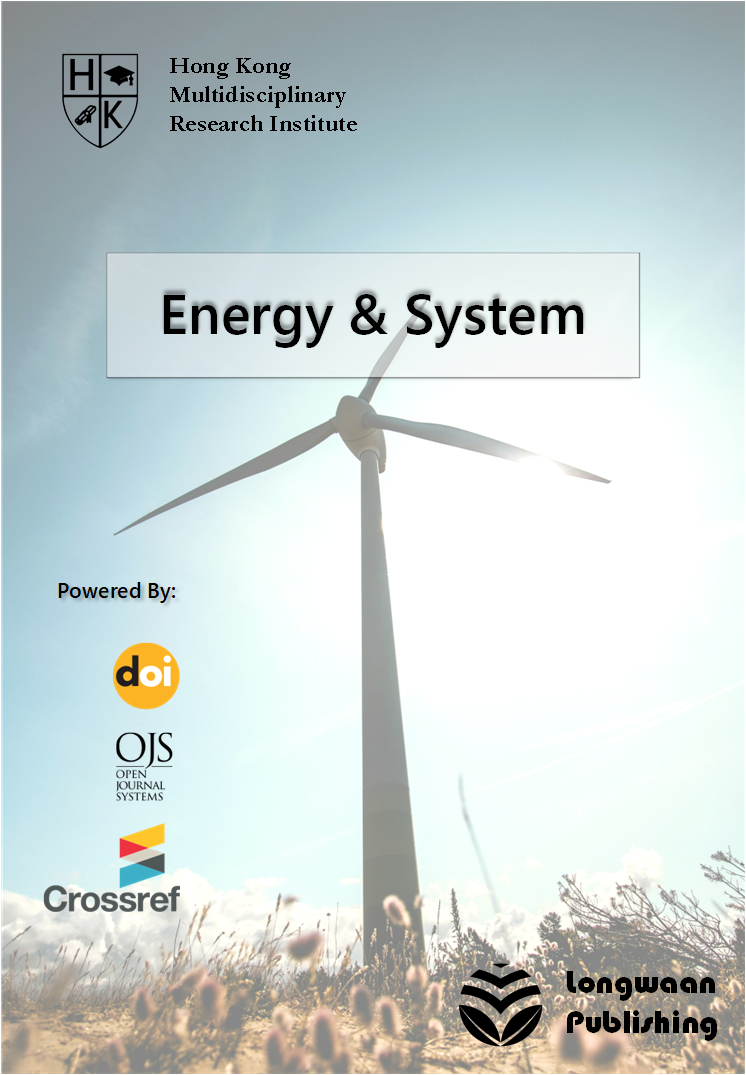Articles
Multi-Scale Numerical Simulation and Optimization Strategies for Wind Farm Layouts in High-Altitude Regions
Published 2024-12-30
Keywords
- Multi-Scale Numerical Simulation,
- Wind Farm Optimization,
- High-Altitude Regions,
- Computational Fluid Dynamics (CFD),
- Genetic Algorithm (GA)
- Particle Swarm Optimization (PSO) ...More
How to Cite
Lefebvre, P., Roy, I., Tremblay, M., & Gagnon, S. (2024). Multi-Scale Numerical Simulation and Optimization Strategies for Wind Farm Layouts in High-Altitude Regions. Energy & System, 4(1), 21–33. https://doi.org/10.71070/es.v4i1.19
Abstract
This study explores the optimization of wind farm layouts in high-altitude regions using a multi-scale numerical simulation approach integrated with advanced optimization strategies. Data were collected from various wind farms in the Tibetan Plateau and the Himalayan region, including wind speed, direction, air density, temperature, and terrain elevation over a five-year period. The research methodology comprised data preprocessing, wind flow modeling via Computational Fluid Dynamics (CFD) and the turbulence model, wind turbine performance modeling based on the Betz limit and Jensen wake model, and optimization using Genetic Algorithm (GA) and Particle Swarm Optimization (PSO). The simulated results were validated against actual data through Root Mean Square Error (RMSE) and sensitivity analysis. The findings reveal substantial enhancements in wind farm performance, with optimized layouts significantly increasing total power output and reducing turbine interference. Specifically, the GA-optimized layout achieved a total power output of 102 MW and an efficiency of 82%, while the PSO-optimized layout attained 101.5 MW and 81.5% efficiency, compared to the initial layout’s 95 MW and 75% efficiency. This research highlights the potential of multi-scale simulations and optimization techniques to improve wind farm efficiency in challenging high-altitude environments.References
- Chaoqun Wang et al. (2023). Calculation Analysis and Improvement Measures of Lightning Strike Trip Rate for Collection Lines of Wind Farm in High Altitude Mountain Area. 2023 3rd International Conference on Electrical Engineering and Mechatronics Technology (ICEEMT), 8-15. https://doi.org/10.1109/ICEEMT59522.2023.10263219
- Tao Feng et al. (2021). Analysis of upper air detection above frozen wind turbine in high-altitude mountains. E3S Web of Conferences. https://doi.org/10.1051/E3SCONF/202126003008
- P. S. Reddy et al. (2021). Comparitive Studies of Futuristic Optimisezed and Regular Solar Panels with Windload Effects on Solar Farms, Solar Panels at High Altitude for Free Green Solar Energy https://doi.org/10.17762/TURCOMAT.V12I6.3197
- R. Brabant et al. (2020). Activity and Behaviour of Nathusius’ Pipistrelle Pipistrellus nathusii at Low and High Altitude in a North Sea Offshore Wind Farm. Acta Chiropterologica, 21, 341-348. https://doi.org/10.3161/15081109acc2019.21.2.009
- Rober Mamani et al. (2018). Efficiency of High Altitude On-shore Wind Turbines: Air Density and Turbulence Effects—Qollpana Wind Farm (Bolivia). Proceedings. https://doi.org/10.3390/ICEM18-05385
- Wenwen Yang et al. (2024). Natural Ice-Melting Mechanism of Wind Turbine Blades in Hilly and Mountainous Wind Farms. 2024 The 9th International Conference on Power and Renewable Energy (ICPRE), 716-722. https://doi.org/10.1109/ICPRE62586.2024.10768439
- Yuval Werber (2024). Human–wildlife conflicts in the aerial habitat: Wind farms are just the beginning. Science Progress, 107. https://doi.org/10.1177/00368504241231157
- Li Yuntin (2014). Wind Resource Assessment Method in High Altitude Mountain Areas Based on NCEP Meteorological Data and SRTM Terrain Data. Electric Power Construction.
- A. K. Mendonça, Antônio Cézar Bornia (2020). Electric power generation in wind farms with pumping kites: levelized cost of energy and sensitivity analysis. Research, Society and Development, 9. https://doi.org/10.33448/rsd-v9i7.4528
- Shuai Wang et al. (2022). Multi-scale numerical simulation of fluidized beds: Model applicability assessment. Particuology. https://doi.org/10.1016/j.partic.2022.11.011
- Yurong He et al. (2022). Multi-Scale Numerical Simulation of Flow, Heat and Mass Transfer Behaviors in Dense Gas-Solid Flows: A Brief Review. Journal of Thermal Science, 31, 607 - 633. https://doi.org/10.1007/s11630-022-1605-x
- Yusuke Sawamura et al. (2021). Multi-scale numerical simulation of impact failure for cylindrical CFRP. Advanced Composite Materials, 30, 19 - 38. https://doi.org/10.1080/09243046.2020.1748789
- Miao Liu et al. (2023). Multi-scale Numerical Simulation of Powder Metallurgy Densification Process. Journal of Physics: Conference Series, 2501. https://doi.org/10.1088/1742-6596/2501/1/012022
- Jun Ding et al. (2020). Multi-scale numerical simulation of fracture behavior of nickel-aluminum alloy by coupled molecular dynamics and cohesive finite element method (CFEM). Theoretical and Applied Fracture Mechanics, 109, 102735. https://doi.org/10.1016/j.tafmec.2020.102735
- Li Wu et al. (2024). A Multi-Scale Numerical Simulation Method Considering Anisotropic Relative Permeability. Processes. https://doi.org/10.3390/pr12092058
- Z. Luo, H. Yan, and X. Pan, ‘Optimizing Transformer Models for Resource-Constrained Environments: A Study on Model Compression Techniques’, Journal of Computational Methods in Engineering Applications, pp. 1–12, Nov. 2023, doi: 10.62836/jcmea.v3i1.030107.
- H. Yan and D. Shao, ‘Enhancing Transformer Training Efficiency with Dynamic Dropout’, Nov. 05, 2024, arXiv: arXiv:2411.03236. doi: 10.48550/arXiv.2411.03236.
- Y. Liu and J. Wang, ‘AI-Driven Health Advice: Evaluating the Potential of Large Language Models as Health Assistants’, Journal of Computational Methods in Engineering Applications, pp. 1–7, Nov. 2023, doi: 10.62836/jcmea.v3i1.030106.
- Zhenyu Lei et al. (2023). A Chaotic Local Search-Based Particle Swarm Optimizer for Large-Scale Complex Wind Farm Layout Optimization. IEEE/CAA Journal of Automatica Sinica, 10, 1168-1180. https://doi.org/10.1109/JAS.2023.123387
- Jared J. Thomas et al. (2023). A comparison of eight optimization methods applied to a wind farm layout optimization problem. Wind Energy Science. https://doi.org/10.5194/wes-8-865-2023
- Weicheng Hu et al. (2023). Wind farm layout optimization in complex terrain based on CFD and IGA-PSO. Energy. https://doi.org/10.1016/j.energy.2023.129745
- Xiaobing Yu, Yangchen Lu (2023). Reinforcement learning-based multi-objective differential evolution for wind farm layout optimization. Energy. https://doi.org/10.1016/j.energy.2023.129300
- Tarique Anwar Qureshi, V. Warudkar (2023). Wind farm layout optimization through optimal wind turbine placement using a hybrid particle swarm optimization and genetic algorithm. Environmental Science and Pollution Research, 30, 77436-77452. https://doi.org/10.1007/s11356-023-27849-7
- M. Ramli et al. (2023). Wind farm layout optimization using a multi-objective electric charged particles optimization and a variable reduction approach. Energy Strategy Reviews. https://doi.org/10.1016/j.esr.2022.101016
- H. Bouchekara et al. (2023). Wind Farm Layout Optimization/Expansion with Real Wind Turbines Using a Multi-Objective EA Based on an Enhanced Inverted Generational Distance Metric Combined with the Two-Archive Algorithm 2. Sustainability. https://doi.org/10.3390/su15032525
- J. Pérez-Rúa et al. (2023). A neighborhood search integer programming approach for wind farm layout optimization. Wind Energy Science. https://doi.org/10.5194/wes-8-1453-2023
- Yang Yu et al. (2023). A chaotic local search-based LSHADE with enhanced memory storage mechanism for wind farm layout optimization. Appl. Soft Comput., 141, 110306. https://doi.org/10.1016/j.asoc.2023.110306

